Let's Explore: Reshaping India’s Political Map | Social Science Class 8 - New NCERT PDF Download
LET’S EXPLORE (Page 26)
Q1. Looking at Fig. 2.6, why do you think Ala-ud-din Khilji called himself ‘the second Alexander’?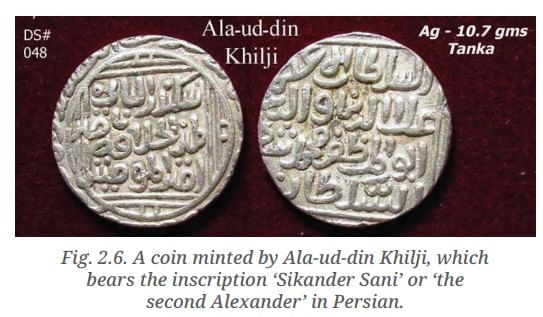
Ans:
- Ala-ud-din Khilji compared himself to Alexander the Great because he conducted successful military campaigns across north and central India, conquering and plundering many cities, just like Alexander's vast conquests.
- He also repelled Mongol invasions, showing his strength as a defender and expander of his empire, similar to Alexander who built one of the largest empires in history.
- The title 'Sikander Sani' on his coin reflects his ambition to be seen as a great conqueror, boosting his image among his subjects and rivals.
Q2. What kind of resources do you think were needed to maintain an army and wage war in those days? Discuss in groups the various types of expenditure involved, from weapons or food for soldiers to animals used in warfare, road construction, etc.
Ans:
- Weapons and equipment: Swords, bows, arrows, and armor required metal, wood, and skilled craftsmen; expenditure on buying or making them was high.
- Food and supplies: Soldiers needed grains, meat, and water; costs for storing and transporting food over long distances during campaigns.
- Animals: Horses, elephants, and camels for transport and battle; expenses on buying, feeding, and training them.
- Soldiers' pay and training: Wages for troops, plus costs for training camps and medical care for injuries.
- Road construction and logistics: Building or repairing roads for army movement; involved labor, materials like stones, and time, adding to overall war costs.
- Other resources: Money from taxes or plunder to fund everything; human resources like spies and engineers for strategy.
THINK ABOUT IT (Page 28)
Q. Why do we use the term ‘image’ rather than common terms like ‘idol’ or ‘icon’? The latter two terms are considered pejorative in the context of Judaism, Christianity and Islam, whose orthodox sects condemn ‘idolatry’ or the worship of ‘idols’ or ‘icons’. India’s classical texts used words like mūrti, vigraha, pratimā, rūpa, etc., to designate images, often statues, used for worship in temples or homes. In English, ‘image’ is a neutral term.
Ans:
- 'Idol' and 'icon' are seen as negative in religions like Judaism, Christianity, and Islam because they imply worshipping false gods or objects, which is forbidden.
- In Indian traditions, words like mūrti or pratimā refer to sacred representations without negative meaning; 'image' is neutral and respectful in English.
- Using 'image' avoids bias and helps describe religious objects fairly, without judging any faith.
THINK ABOUT IT (Page 29)
Q. During the time of the Tughlaqs, the Musunuri Nayakas, Telugu chieftains, rallied over 75 more chieftains of the region, formed a confederacy that defeated smaller provinces, formed a confederacy that defeated the Delhi Sultanate forces, and expelled Muhammad bin Tughlaq’s army from Warangal (present-day Telangana) around 1330-1336. Do you think it would have been an easy task to bring together 75 leaders in those days?
Ans:
- No, it was not easy because communication was slow without modern tools like phones or emails; messengers on horseback took days to travel.
- Leaders had their own rivalries, egos, and local interests, making agreement on a common goal challenging.
- They needed strong motivation, like shared hatred for the Sultanate's oppression, and good leadership to unite them against a common enemy.
- Risks like betrayal or failure made it hard, but their success shows effective planning and trust-building.
LET’S EXPLORE. (Page 31)
Q. Why do you think such locations were chosen for many of the medieval forts? Discuss pros and cons. (Hint: think of issues of strategy, security, vulnerability, etc.)
Ans:
- Pros: High hills or forests provided natural defense, making it hard for enemies to attack; e.g., steep slopes slowed invaders.
- Good visibility from heights for spotting approaching armies early; strategic for controlling surrounding areas.
- Natural resources like water or food nearby helped during sieges.
- Cons: Difficult to supply food and water uphill; vulnerability to blockades cutting off resources.
- Hard to build and maintain due to terrain; risk of isolation if roads were poor.
- In bad weather, like rains, slippery paths could cause accidents or hinder movement.
THINK ABOUT IT (Page 32)
Q. Have you noticed the term pati in titles like ‘Gajapati’? Pati means ‘lord’ or ‘master’ and was commonly used by many ruling dynasties of this period to signify power and stature. The Vijayanagara kings were called ‘Narapati’, the Bahmani Sultanate rulers ‘Ashwapati’, and the Maratha rulers ‘Chhatrapati’ — each title reflecting different aspects of kingship and power. Can you guess what these three terms might mean?
Ans:
- 'Narapati' likely means 'lord of men' or 'master of people', showing control over subjects (nara means human in Sanskrit).
- 'Ashwapati' probably means 'lord of horses', highlighting command over cavalry, important for warfare and mobility.
- 'Chhatrapati' could mean 'lord of the umbrella' or 'protected lord', where chhatra (umbrella) symbolizes royal protection and authority over land.
LET’S EXPLORE. (Page 35)
Q. In Fig. 2.14, what elements do you observe? What do they tell you about life then? (Hint: observe the weapons, the animals, the activities.)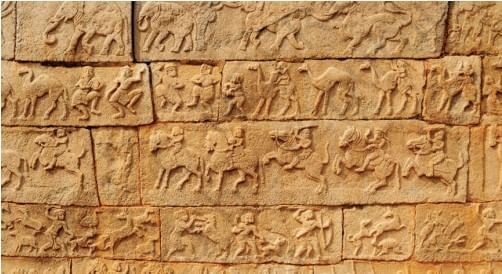 Fig. 2.14. A panel from the Vitthala temple
Fig. 2.14. A panel from the Vitthala temple
Ans:
- Elements observed: Soldiers with swords, spears, and shields; horses and elephants in battle; people trading or farming.
- About life then: Shows a military-focused society with strong armies for protection; animals like elephants indicate advanced warfare tactics.
- Daily activities like trading suggest a prosperous economy; carvings reflect cultural importance of art, religion, and community events.
- Overall, life was vibrant but challenging, with focus on defense, trade, and royal grandeur in Vijayanagara.
THINK ABOUT IT (Page 37)
Q. What strikes you in Babur’s impressions of India? Discuss in groups.
Ans:
- Babur found India lacking in charms compared to Central Asia, like few pleasant landscapes or fruits he liked.
- He appreciated India's wealth in gold and silver, skilled artisans, and healthy rainy season air.
- Striking is his mix of criticism (hot climate, dusty) and praise (large population, resources), showing why he stayed despite nostalgia.
- His detailed notes on birds and plants reveal him as observant and cultured, but ruthless in conquests.
THINK ABOUT IT (Page 40)
Q. Why do you think Akbar employed different strategies to expand his empire, while the earlier rulers of Delhi relied mostly on military might?
Ans:
- Akbar used alliances, marriages, and diplomacy with Rajputs to gain loyalty without constant wars, unlike Delhi sultans' focus on force.
- He promoted religious tolerance (abolished jizya) to unite diverse groups, reducing rebellions and building a stable empire.
- Earlier rulers faced instability, so relied on military; Akbar's long reign allowed smarter policies like revenue reforms for economic strength.
- His curiosity about other faiths led to inclusive governance, making expansion sustainable.
LET’S EXPLORE (Page 41)
Q. Compare the maps in Figs. 2.3, 2.12 and 2.16. What differences do you notice? What is the ‘reshaping’ that has occurred?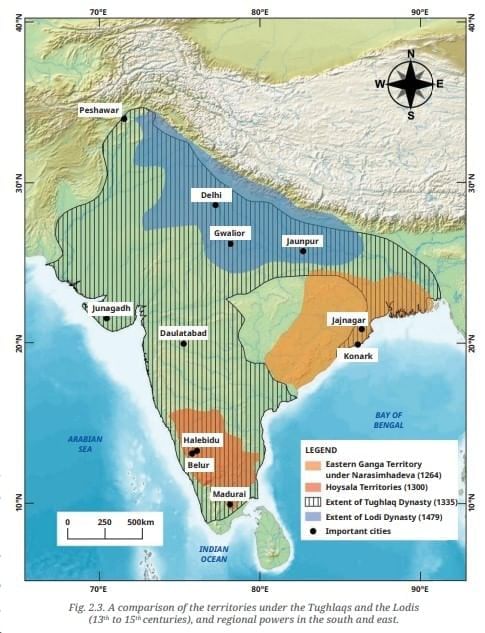
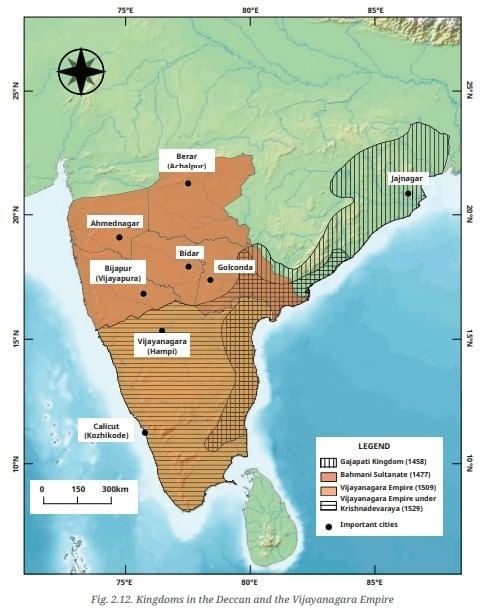
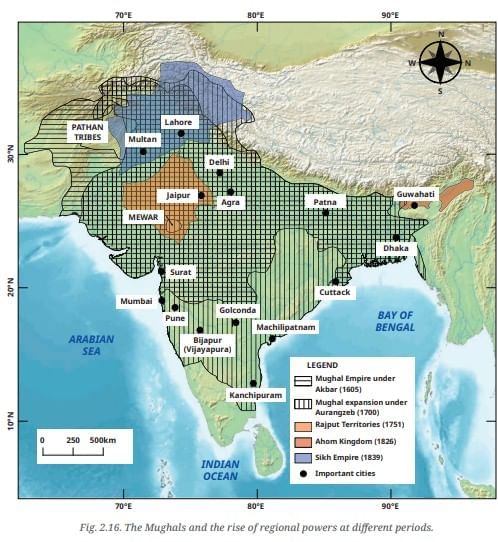
Reshaping: Political map changed from small regional powers to large empires through conquests, alliances, and declines; shows centralization and foreign influences altering boundaries.
THINK ABOUT IT (Page 43)
Q. We saw above that Delhi sultans’ average reign lasted about nine years. This figure becomes 27 years in the case of Mughal emperors up to Aurangzeb; and 16 years if we consider all Mughal rulers, up to the end of the empire in the 19th century. What do you make of these numbers of years of reign?
Ans:
- Delhi sultans had short reigns due to violent successions and instability, leading to frequent changes and weak rule.
- Mughals had longer reigns (up to 27 years average) because of better administration, family loyalty, and effective policies reducing coups.
- Overall 16 years for all Mughals shows later decline with shorter reigns; indicates stronger early governance but eventual weakening.
LET’S EXPLORE (Page 45)
Q. In his last letters to two of his sons, Aurangzeb wrote, “I came alone and am going away alone. I know not who I am and what I have been doing. … I have not done well for the country and the people, and of the future there is no hope. I was helpless [in life] and I am departing helpless.” What do these words tell us about Aurangzeb? How do you feel about them?
Ans:
- About Aurangzeb: Shows regret and reflection in old age; despite conquests, he felt unfulfilled, questioning his harsh policies and wars.
- Indicates loneliness and helplessness, perhaps from family conflicts and empire strains.
- Feelings: Sad and thoughtful; reminds us even powerful rulers face doubts; teaches importance of balanced leadership for people's good.
LET’S EXPLORE (Page 48)
Q. Discuss in class how the paik system affected the daily lives of the people in the Ahom kingdom, both in terms of challenges and benefits, and helped the king manage both the army and the economy.
Ans:
- Benefits: Every man got land for service, ensuring fair distribution; built strong community and infrastructure like roads.
- Helped king maintain large army without full-time pay, using rotation; boosted economy through labor in farming and building.
- Challenges: Disrupted daily farming or family life with mandatory service; physical risks in military duty.
- For king: Efficient management of resources, quick mobilization for defense; promoted loyalty and self-sufficiency.
LET’S EXPLORE (Page 49)
Q. How did the Ahoms use the rivers, hills and forests of Assam to their advantage? Can you think of ways in which the geography helped them build defences and fight wars?
Ans:
- Rivers: Used for fast boat movements in battles (e.g., Saraighat); natural barriers against invaders.
- Hills and forests: Hid troops for guerrilla attacks; dense terrain slowed enemy armies, giving ambush opportunities.
- Defences and wars: Built forts on hills for oversight; rivers for supply lines; geography aided in repelling Mughals by tiring them out in unfamiliar land.
THINK ABOUT IT (Page 52)
Q. Why do you think Guru Tegh Bahadur endured torture rather than convert? Why did he think his sacrifice would make a difference? What values did the Sikh Gurus and the Khalsa embody? How are they relevant in today’s world?
Ans:
- Endured torture: To defend religious freedom and resist forced conversion; showed faith in equality and justice.
- Sacrifice's difference: Inspired others to stand against oppression, protecting Kashmiri Pandits and promoting unity.
- Values: Courage, equality, service, and resistance to injustice; Khalsa emphasized discipline and protection of weak.
- Relevance today: Teach tolerance in diverse societies; encourage standing up for rights and community service in modern conflicts.
|
31 videos|128 docs|7 tests
|
FAQs on Let's Explore: Reshaping India’s Political Map - Social Science Class 8 - New NCERT
| 1. What were the main factors that led to the rise of the Delhi Sultanate? |  |
| 2. How did the Delhi Sultanate impact the socio-cultural landscape of India? |  |
| 3. What were the key dynasties that ruled during the Delhi Sultanate period? |  |
| 4. What led to the decline of the Delhi Sultanate? |  |
| 5. How did the Delhi Sultanate pave the way for the Mughal Empire? |  |





















